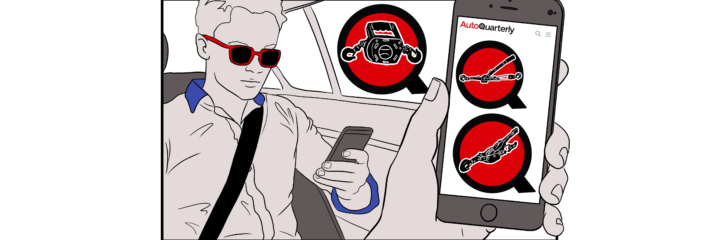There’s a saying that owning quality tools pays dividends in the long term, and with winches, it’s especially true. Especially in more hazardous applications, such as lifting and pulling heavy weights, it’s incredibly important to have the correct tool for the job.
Come along winches are used to drag, tow, haul, or lift a heavy weight with hand power. They’re hooked to a sturdy anchor point while a system of gears and levers creates. Most winches incorporate gears and a lever to make the weight easier to load or lift, as well as some type of release to allow the cord to go back out. No matter the application, object, or the difficulty of the job, a come along winch can get it done.
- Factors to Consider in a Come Along Winch
- Top 10 Best Come Along Winches 2025
- 1. Best Overall Come Along Winch: Tekton 5547 4-Ton Dual Gear Power Puller
- 2. Best Budget Come Along Winch: Maasdam Pow’R Pull 2 Ton
- 3. Best Premium Come Along Winch: Warn Handheld Portable Drill Winch
- 4. Easiest Come Along Winch to Use: TR Industrial Portable 4-Ton Dual Gear Power Puller
- 5. Best Electric Come Along Winch: Warn PullzAll Corded 120V AC Portable Electric Winch
- 6. Most Versatile Come Along Winch: Maasdam Pow’R Pull Web Strap Pull’R
- 7. Safest Come Along Winch: Wyeth 3 Ton Ratchet Puller
- 8. Big Red Torin Come-Along Double Gear Hand Cable Puller
- 9. Best High-Capacity Come Along Winch: Neiko Power Cable Puller
- 10. Best Simple Come Along Winch: ABN Heavy-Duty Hand Puller With Cable Rope
- Guide to Buying the Best Come Along Winch
- Wrapping Up
Factors to Consider in a Come Along Winch
Whether you are expanding your tool arsenal, replacing a broken winch, or buying the tool for a specific use, it’s important to pick a high-quality winch with the features you’re looking for. For some, that’s a high weight limit, for others, it is a strong warranty and good attention to safety. Whatever you’re looking for, make sure you consider the following factors when shopping.
Weight Limit
The single most important consideration in a come along winch is its weight limit. At or below its limit, a winch is incredibly unlikely to fail, but once you begin to go over that limit, you can run into serious trouble, especially as a cord under tension can store a lot of energy that can be released rapidly. Do some serious thinking as to how much weight you need, as higher limits require more money and weigh a lot more.
Handle Length
Handle length isn’t just important to make sure you’ve got a decently-sized, well-made product, it’s important for leverage as well. When you hoist a winch, a longer handle will provide more leverage and make hoisting, hauling, or pulling easier.
Powered Winches
Some winches don’t use hand leverage to power their pulling action, instead using a small electric motor to apply pulling force. While they’re powered, meaning they don’t typically require much force, the type of electric motor employed is relatively weak, yielding quite low weight limits. They’re an option to be considered if you’re frequently winching midweight (half-ton and under) objects.
Winch Weight
It’s important to think about the weight of the winch itself when shopping around, as most often winches are used on the go and thus must be transported. Something you want to fit in your backpack will have a smaller weight limit than something you leave in the toolbox of your truck, for example.
Safety Features
As with any tool, safety comes first. Along with a high weight limit, you can look for a come along winch with a quick release, braided wire, rubber-coated fittings, or other safety-sensitive touches that can help you stay safe during regular use or in the unlikely event of a product failure.
Considering the following features, let’s take a look at some of our favorite come along winches on the market. Pick the right one, and you’ll end up with a reliable tool that can get you out of jams and tough spots for years to come.
| Product | Weight Limit | Winch Weight | Rating |
|---|---|---|---|
| Tekton 5547 4-Ton Dual Gear Power Puller | 2-ton/ 4-ton | 13 lbs | 5 |
| Maasdam Pow’R Pull 2 Ton | 2 tons | 8.75 lbs | 5 |
| Warn Handheld Portable Drill Winch | 750 lbs | 13 lbs | 5 |
| TR Industrial Portable 4-Ton Dual Gear Power Puller | 4 tons | 12 lbs | 4.5 |
| Warn PullzAll Corded 120V AC Portable Electric Winch | .5 tons | 15 lbs | 4.5 |
| Maasdam Pow’R Pull Web Strap Pull’R | 1 Ton | 8.33 lbs | 4 |
| Wyeth 3 Ton Ratchet Puller | 3 tons | 24 lbs | 4 |
| Big Red Torin Come-Along Double Gear Hand Cable Puller | 2 ton / 4 ton | 7 lbs | 4 |
| Neiko Power Cable Puller | 5 tons | 13 lbs | 4 |
| ABN Heavy-Duty Hand Puller With Cable Rope | 4 ton | 11 lbs | 3.5 |
Top 10 Best Come Along Winches 2025
1. Best Overall Come Along Winch: Tekton 5547 4-Ton Dual Gear Power Puller

Editor’s Rating:
At a Glance
- Weight Limit: 2-ton/ 4-ton
- Winch Weight: 13 lbs
This 4-ton dual-gear winch tops our list for one reason: its double gear power puller. So if the biggest distinguishing factor is thanks to its unique mechanics (a dual-gear winch), what is the purpose of a single gear puller, then? A single gear-puller is a geared system to turn leverage from a handle to rotational energy with gears.
Thus, a dual-gear puller distributes the load across two separate gear units, meaning it’s twice as easy to lift the same load. It’s no problem to lift multiple ton loads with just one hand, with locking pawls that prevent the load from rolling backward.
The steel cable that drives the winch is ¼-inch aircraft-grade, with a corrosion-resistant coating that can hold up to 4-tons in the heavy-duty version and 2-tons in the lightweight model. A 21-inch handle provides ample leverage, but the flat handle with a nonslip grip isn’t too comfortable to use. This is a pretty minor flaw in an excellent unit, but those who want a more luxurious experience can upgrade to the Warn Handheld Portable Drill Winch.
Thankfully, as all parts are made of galvanized steel, it will hold up incredibly well. Both hooks are galvanized with self-closing safety latches that add a bit of security to the whole system.
Safety Features
The most prominent safety feature for this pulley is one of its biggest selling points in the first place: the dual pulley system. Not only does the double pulley system make dragging or loading easier, it also provides a backup carrying method if one of the pulleys fails. You’ll have to replace it in case of a failure, but it will hold the load in a pinch. A four-ton cable and a solid metal construction only add to the confidence we have in the product.
Pros
- Double gear puller is reliable and easy to use
- Powerful 21-inch handle for leverage
- Uses a construction of galvanized steel
- Self-closing safety latches automatically for additional security
Cons
- Flat handle with nonslip grip isn’t comfortable to use
2. Best Budget Come Along Winch: Maasdam Pow’R Pull 2 Ton
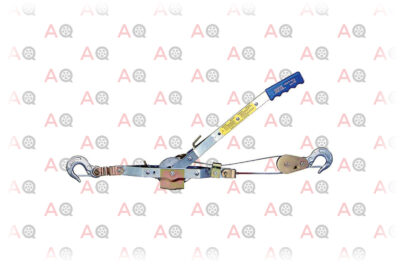
Editor’s Rating:
At a Glance
- Weight Limit: 2 tons
- Winch Weight: 8.75 lbs
This solid two-ton winch is similar to a different product made by the same manufacturer as the Maasdam Pow’r Pull Web Strap Pull’r. Instead of that winch’s web strapping, however, this winch uses heavy-duty aircraft cable to yield a higher weight limit, hauling up to two tons compared to the webbed versions one-ton limit. It’s still not as impressive as 4-ton winches such as TR Industrial Portable 4-Ton Dual Gear Power Puller, however.
The tool is USA-made, in fact, all winches from Maasdam are manufactured stateside. But the company’s reputation doesn’t just come from the location of their manufacturing facilities: the interior gear components are electro-plated, the steel hooks at both ends are drop forged, and the cable itself is aircraft-quality. Best of all, the company offers a full lifetime warranty in case of any defect or product failure.
Safety Features
The safety feature that gives us the most trust in this winch is the material and fabrication process itself: the winch body is nearly entirely made of galvanized steel. It’s still primarily held together with rivets and screws, but the whole body of this winch is a single piece of metal, meaning there’s no single piece besides the fasteners that represents a weak point. This gives it phenomenal durability at a low weight: it comes in at well under 8.75 pounds.
Pros
- Aircraft cable yields a higher weight limit
- American manufactured with high-quality parts
- Lightweight winch weighs in at under 8.75 pounds
- Galvanized steel improves both strength and weight
- Full lifetime manufacturer defect warranty
Cons
- Weight limit is half that of other winches

Editor’s Rating:
At a Glance
- Weight Limit: 750 lbs
- Winch Weight: 13 lbs
This lightweight powered winch is a great middle-ground option for anyone looking for a lightweight yet motor-powered winch. Unlike more powerful electric winches, it’s wireless, using a handheld drill (not included) to pull weight instead of relying on plug-in shore power. Unfortunately, that means you’ll need a powered drill on hand, another cost added to the already more-expensive-than-average winch.
So what’s the bad, then? Weight limit, especially considering the winch’s high price. In fact, this 750-pound version is about double the price of its smaller sibling, the 500-pound-limit Warn 910500. It’s a lot of money for a winch that only hauls an eighth of the weight of competitor products, although admittedly, as a motor-powered drill winch, it’s in a different class. Either way, you’re paying quite a bit to lift just 750 pounds when you can get four-ton winches for under $50.
Safety Features
There are a couple of unique safety features that come with this winch and its robust price tag, all of which are rare on hand-powered winches. Firstly and most importantly, it’s got a load limiter that makes the winch nearly impossible to overwork. Pulling something overweight? The load limiter detects it and engages a ratchet, meaning you can’t pull something that’s too heavy, and thus won’t be able to drop or damage it. A free-spool clutch wraps the winch’s 30-feet of wire reliably and without overlapping, preventing it from wearing out over time.
Pros
- Good middle-ground option for a lightweight yet powered winch
- Doesn’t require shore power
- Load limiter makes it impossible to overload the winch
- Free-spool clutch wraps the wire reliably and safely
Cons
- Expensive price tag and low weight limit
- Requires the additional purchase of a drill
4. Easiest Come Along Winch to Use: TR Industrial Portable 4-Ton Dual Gear Power Puller

Editor’s Rating:
At a Glance
- Weight Limit: 4 tons
- Winch Weight: 12 lbs
With sturdy finishes and impressive build quality, this 4-ton puller is incredibly impressive for its price: it’s evident that no corners were cut building and designing the product. That goes for everything from the internal mechanics to the user features: the dual-gear system inspires confidence with slick, smooth ratcheting action and the hardware is all galvanized and slickly polished.
It comes in an incredibly sturdy plastic box storage case with a strong, flexible handle, making it perfect for storage in your vehicle, truck cab, or garage. This doesn’t just make it easy to transport, but also protects it from the elements. Our only problem with the winch is its short pulling distance: the device reaches maximum extension at a little over four feet, so it’s more fit for connecting heavy trailers to trucks than work at a construction site, for example.
Safety Features
While this device claims a fantastic maximum working weight of 4 tons, the truth is a little more nuanced. While the claimed maximum capacity is, indeed, a true 8,000 pounds (the manufacturer’s rated capacity), the working weight limit is just around half of that at 2 tons. That’s fine for most applications, but it feels a little deceptive: from the owner’s manual to real life, you lose 4,000 pounds of carrying capacity.
Pros
- Sturdy finishes and strong build quality
- Impressive design and engineering for a low price
- Includes carrying case for storage and protection
Cons
- Working weight limit is half of the manufacturer’s rated capacity
- Maximum extension only reaches about four feet
5. Best Electric Come Along Winch: Warn PullzAll Corded 120V AC Portable Electric Winch

Editor’s Rating:
At a Glance
- Weight Limit: .5 tons
- Winch Weight: 15 lbs
This Chinese-made winch is one of the heaviest on our list at 15 pounds, but it’s not like the weight is there for no reason: most of the weight, in fact, comes from the electric motor it employs, which completely eliminates the need for a handle, or any human input after hooking up the anchor points, for that matter. That lack of a handle, however, means that you’ll always need shore power when using this winch.
If for any reason you need to pull an object along at quick speed, this winch works incredibly well, with a quick line speed of 13.8 feet per minute pulling quicker than most hand-powered winches, although admittedly not at any meaningfully quick space. But if you’re using a winch all day, it will definitely save you some time.
Safety Features
While this winch does have a largely plastic construction, it’s still durable and maintains a lower-than-average but still more than usable half-ton weight limit. The weak point isn’t the construction, or even the cable for that matter, but the motor itself, which will break if you even attempt pulling a heavier weight. Both hooking anchor points have automatic catches to make sure they stay in place.
Pros
- Can be a huge time saver if you’re working on a day-long project
- 13.8 feet per minute line speed is much faster than hand-powered winches
- Design eliminates the need for a handle
- Anchor points have automatic catches for safety
Cons
- Motor can fail when pushed to the limit
- Needs to be plugged in to be used
6. Most Versatile Come Along Winch: Maasdam Pow’R Pull Web Strap Pull’R
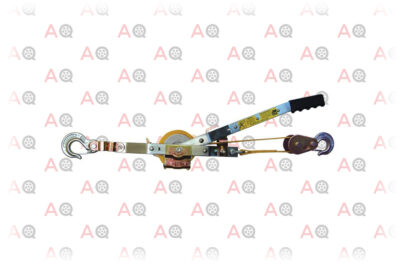
Editor’s Rating:
At a Glance
- Weight Limit: 1 Ton
- Winch Weight: 8.33 lbs
This winch from company Maasdam uses a slightly different format than other come along winches, with one side holding the weight with steel wire and the other side using fabric webbing. This means that you can extend the winch’s working range on the anchor side by feeding out the steel cable, simultaneously using the fabric strap for stability on the tow side.
The weight capacity, unfortunately, is capped out at one ton, as steel cabling conventionally used with winches has a higher weight capacity than web straps. That brings a weight limit penalty, but actually opens up some possibilities for anchor points. While it’s dangerous to hook a steel wire to itself, you can hook a web strap to itself, and it’s more flexible as well, especially useful when you need to use a tree or other fragile/irregular object as an anchor point.
If you need to haul over a ton, the Wyeth 3 Ton Ratchet Puller offers similar versatility with a higher weight limit, albeit with a higher price to match.
Safety Features
The strongest safety feature with this winch doesn’t protect the user at all, instead protecting the delicate nature of whatever you’re hauling. Webbing or fabric straps don’t need an anchor point, nor are they likely to wear away paint or any coating/seal of the object you’re hauling. If you’re towing something with cosmetic value, use web straps instead of a steel cable. It still relies on all of the safety features of other comparable winches.
Pros
- Web strap can be hooked to itself when hauling
- Can hook this winch to more delicate objects thanks to web strap
- Doesn’t scratch paint or cause friction
- Has the same safety features as comparable winches
Cons
- Weight capacity tops out at one ton
- Web strap is more susceptible to wear than metal wire
7. Safest Come Along Winch: Wyeth 3 Ton Ratchet Puller
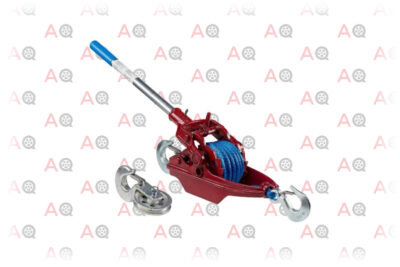
Editor’s Rating:
At a Glance
- Weight Limit: 3 tons
- Winch Weight: 24 lbs
This incredibly sturdy three-ton puller provides confidence with a thick metal construction and a wide, braided wire, enough to pull up to three tons without so much as a squeak. This comes at odds with the fact that it’s heavier than other winches at almost 24 pounds. Most of that weight is thanks to its cast construction and the large amount of rope available.
That’s one of the things we like most about this winch: its long, 35-foot cable length. Some come along winches have annoyingly short cables, yielding a winch that’s only useful when the object you’re pulling is nearby. 35 feet of rope gives you a lot of slack to play with, and you can stretch that cable across gaps, or use it to reach an object that’s offroad while keeping your machinery on concrete to get more traction. A large amount of cable does add to the device’s weight, unfortunately.
Safety Features
There’s one major difference between this puller and other options: the type of cable used. Instead of metal braided aircraft cables that store energy and can snap out violently when they fail, this winch uses a 12-strand Dyneema SK-75 fiber that’s more like a rope than a metal cable. If this rope fails (it almost certainly won’t, as it’s got a 7-ton weight limit), it breaks in a predictable way. Instead of whipping out as with metal cables, it fails perpendicular to the weight, meaning it doesn’t present a risk of hurting the winch operator. This alone justifies its high price for many users. But if you’re never lifting anything near 3 tons, it’s overkill, and a cheaper option from our list will suffice.
Pros
- 12-strand Dyneema SK-75 Fiber is incredibly safe to use
- 35 feet of rope gives you a lot of room to play with
- Cast construction is durable and has no weak points.
- Synthetic rope itself has a mind-blowing seven-ton weight limit
Cons
- Rope and metal construction add up to a 25-pound weight
- High price compared to winches with similar weight limits
8. Big Red Torin Come-Along Double Gear Hand Cable Puller

Editor’s Rating:
At a Glance
- Weight Limit: 2 ton / 4 ton
- Winch Weight: 7 lbs
Cheap, strong, and high weight limits are all strong selling points for this winch, which has a completely solid steel body and long-lasting performance. The ratchet system uses a double gear system to hold weight, ideal for easy hauling as well as providing security. The winch anchors use galvanized hooks, which should inspire a great deal of confidence.
It’s got two options available as far as weight goes regarding manufacturer rated capacity, although we find the lightweight, two-ton winch to be more expensive than other options with a similar weight capacity. Both of the versions use the same body, while the smaller two-ton version uses different hardware and a different gear hand cable puller. Both count on metal aircraft wire for pulling: if you’re looking for a safer, synthetic option, consider the pricier Wyeth 3 Ton Ratchet Puller.
Safety Features
The best defense is a good offense, so a four-ton weight limit is not only impressive, but comes in at a minimal weight penalty when running around with the winch. The ratchet releases one notch at a time, which is a bit slow, but perfect for small adjustments when you need to position a heavy object. Both of these features keep you and others nearby safe.
Pros
- Cheap and strong with a high four-ton weight limit
- Ratchet system uses dual gears to distribute the load
- Winch anchors come with galvanized hooks
- Notches are perfect for minor adjustments
Cons
- Version with two-ton limit is expensive for its capacity
- Uses aircraft wire which can be dangerous
9. Best High-Capacity Come Along Winch: Neiko Power Cable Puller
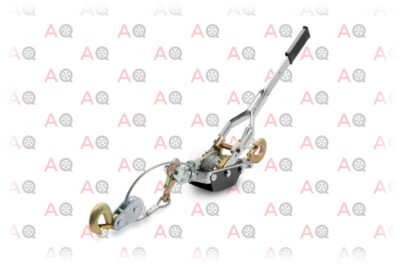
Editor’s Rating:
At a Glance
- Weight Limit: 5 tons
- Winch Weight: 13 lbs
This inexpensive winch has an incredibly impressive five-ton weight limit that makes it incredibly useful in case of emergencies, incredibly considering its lightweight construction. Unlike compact car winches like the four foot TR Industrial Portable 4-Ton Dual Gear Power Puller, which are better for automotive use, this winch’s 12-foot length is more useful in a wide variety of scenarios, but with less specificity.
Pulling all that weight, though, will require a fair bit of leverage, which comes via an extra-long handle coated in PVC. The double gear system helps make pulling heavy weights easy, and it will stay operating smoothly for years, even in rough conditions thanks to a zinc coating that prevents oxidation. A third latching hook can help distribute the weight to a secondary anchor point, stabilizing the load even further.
There’s one issue, though: the five-ton weight is a measurement under ideal scenarios, and in most real-world applications, the usable weight limit will be around 2.5 tons.
Safety Features
This winch has a host of safety features, some of which protect the user and some of which prevent catastrophic failure. Heavy-duty steel construction adds durability, while the ratcheting system has tight tooth spacing to prevent long drops. The long handle doesn’t just provide more leverage, but also more control from the user. The less the user needs to strain to lift the load, the more they can focus on the safety factors behind lifting the load itself.
Pros
- User doesn’t have to strain to lift the load
- Zinc coated gears prevent corrosion
- Long handle with PVC coating provides leverage
- Good for a wide variety of uses
Cons
- Better for broad applications than specific ones
- Load limit in real-world scenarios is about half of the quoted weight
10. Best Simple Come Along Winch: ABN Heavy-Duty Hand Puller With Cable Rope
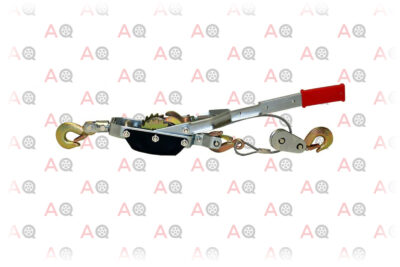
Editor’s Rating:
At a Glance
- Weight Limit: 4 ton
- Winch Weight: 11 lbs
This simple come along winch isn’t perfect by any means, but it’s an absolute workhorse with a four-ton weight limit. Its total steel construction, low price, and simplicity make it great for an amateur’s workshop, although commercial shops might look for something with a higher weight limit like the Neiko Power Cable Puller.
With the good comes the bad, although the bad is certainly manageable. It won’t fail on you all at once, but the body is largely held together by rivets that will begin to bend over time. The winch body isn’t solid, so it’s more susceptible to bending, and thus fatiguing over time. The gears are made of a galvanized steel, but the plates themselves are thin, so the ratchet might give you some trouble after extensive use. It won’t fail catastrophically, but it’s not as long-lasting as other models.
Safety Features
With a simple and useful safety manual, a well-built mechanism, and all-steel construction, it’s evident that safety was a significant design factor when producing this ABN Heavy-Duty hand puller. Beyond the normal, though, there’s nothing really unique from a safety perspective. It uses conventional aircraft cable, the same galvanized hooks as other models, and spring safety latches to make sure the hooks hang tight onto their anchor points.
Pros
- Phenomenal for amateur workshops
- Constructed completely of steel
- Winch fatigues over time but won’t fail catastrophically
- Gears are made of galvanized steel
Cons
- Commercial users might want to look for something a bit more reliable
- Held together by rivets that can fatigue over time
- Ratchet can wear out over time due to thin gear plates
Guide to Buying the Best Come Along Winch
Buying a come-along winch is incredibly useful, but you’ve got to put some attention in to make sure you purchase the right product. Make sure to buy a winch that works for your needs, with larger weight limits being more expensive but simultaneously more capable. Keep in mind the fact that you can always use a large winch for a light object, but you can’t use a lightweight winch for a heavy object.
A Safety Note on Working Weight
While winches typically only advertise their maximum weight, it’s not the only number that matters when using this type of tool. The maximum weight of a winch is neither static nor ‘set it and forget it.’ There are really two numbers to focus on when using a come along winch: manufacturer’s rated capacity and working load limit (also known as working weight).
Manufacturer’s Rated Capacity
This weight is the number you see on your winches packaging as well as the weight that we quote in our product description. This weight is a maximum weight measured under lab scenarios with accurate equipment in highly controlled scenarios. Because it’s so precise, this measurement doesn’t take in to account real-world factors such as wind, fatigue, or poorly balanced weights. Think of this number as a hard limit that you should never exceed.
Working Weight Limit
Working weight limit is the number you’ll use in the real world when you have any doubts on the consistency of your work conditions. This is a weight limit where you can be incredibly certain that your winch will not fail, even in unique circumstances that present higher risks. It’s typically about half the Manufacturer’s Rated Capacity (MRC) and can be found in your winch’s user manual.
Come Along Winch Applications
While most come along winch buyers have a particular application in mind, come along winches are quite a bit more versatile than you could expect, useful in automotive applications, lawn and garden work, construction, and more.
Have you ever heard that phrase about an unstoppable force and an immovable object? Well, a come along winch is the closest you can get to an unstoppable force for around fifty bucks. Come along winches can be used for the following:
- Loading a Trailer: Use a come along to drag or roll heavy objects up an inclined trailer ramp.
- Attaching a Trailer: A come along winch can pull a heavy wheeled trailer directly in line with a hitch when hooked up properly.
- Landscaping: If you can get an attachment point set up, a come along winch can pull out stumps, drag rocks, or move other heavy objects. Consider a webbed come along winch like the Maasdam Pow’r Pull Web Strap Pull’r if you’re mainly hauling objects without an anchor point.
- Framing: Relatively flexible steel wiring becomes rigid under tension, making it perfect for applying leverage on objects. Use your come along to lift up framing from flat to perpendicular with the ground.
- Pulling Out Dents: If you don’t have the budget for professional dent remover, purchase an inexpensive suction cup with an anchor point, then tug on the dent with a come along. Be careful, and understand it might not come out perfectly, but it can be an inexpensive way to fix a significant problem. If you’re doing this, we’d recommend something without a metal cable, like the Wyeth 3 Ton Ratchet Puller.
Getting the Most Out of Your Come Along Winch
Come along winches are a remarkably versatile tool, but oftentimes they’re thought of as a relatively singular solution to hauling problems. It’s true, to some extent: a come-along winch can only drag heavy objects in a single direction. But if you’re clever with your setup, the fact that they only work perpendicularly isn’t a disadvantage, but an advantage.
How Do I Use a Come Along Winch?
Hauling big, heavy objects can be stressful, but with a sturdy winch, it’s a lot easier. Follow your manufacturing directions regarding safety, then follow these constructions. It’s like learning any skill: with each attempt, you’ll get a lot better.
Plan Out Your Approach
Make sure you plan things out before positioning yourself, your object, and your anchor. Consider the friction of the surface, the angle, and any obstacles. Make sure you’re maximizing the friction of your anchor point (you can do this with wheel blocks or even by applying the handbrake) and minimizing the friction against the obstacle you’re hauling (putting it on wheels, for example). Finally, plan out where the object you’re holding is going to end its journey.
Hook Up Your Winch
After you’ve got your approach thought out, hook your anchor and object together. This should be a straight line if at all possible, with each side hooking up to an anchors
Clear the Area
Clearing the area is an important step that sometimes gets skipped. Clear the area of obstacles that might interfere in your tow path, but also clear the area of people who don’t need to be there.
Use Your Ratchet
Once everything is hooked up and clear, you can start. Take it slow! There’s no reason to rush it, and going quickly applies unneeded pressure on your equipment. With each turn of the rachet, your object will get slightly closer. If you hit a snag, make sure the object’s path is clear, then go back to hauling.
Unhook Your Winch
Once your object has arrived at its final point, make sure it’s stably resting and won’t move from that point. When you’re sure it’s properly situated, you can unhook your winch after releasing the tension on the wire. When in doubt, assume that the heavy object is not securely situated. Heavy objects are dangerous, and when they’re uphill, even more so.
Come Along Winch Maintenance
As tools with moving, fatiguing parts, and gears that wear out, it’s important to think a little bit about how to keep your winch in great operating condition and keeping it well lubricated. Follow these maintenance steps for some quick things that will extend the working life of your device.
- Avoid Water: Water is a winch’s worst enemy, as steel oxidizes when exposed to air. This won’t only gum up the winches, making them harder to use, but also corrodes the wire, reducing its effective weight limit. Keep things adequately lubricated and only use the winch when dry if possible to minimize corrosion.
- Lubrication: A come along winch doesn’t simply maintain itself. Place a light, non-viscous lubricant on moving parts to reduce corrosion and minimize friction on metal parts
- Proper Alignment: Metal wire and mechanical winches themselves lose strength if they’re twisted. The flatter you can maintain your winch, the more weight it will be able to support and the less likely it will be to fail in the long term.
Come Along Winch Safety
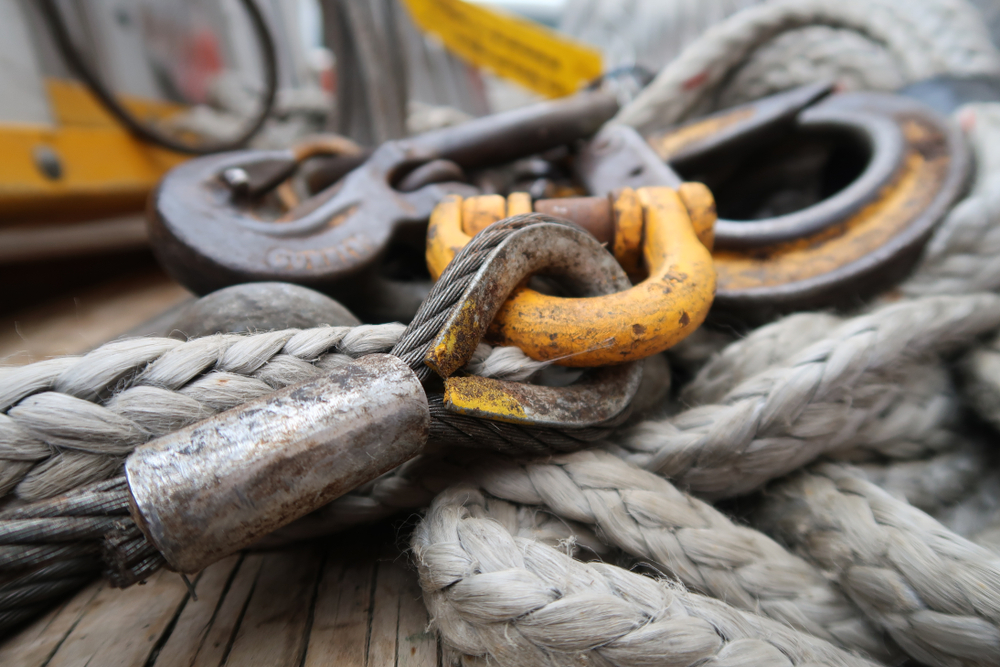
Come along winches are an incredibly useful tool, but when used incorrectly, they can be incredibly destructive. Not only will misuse drop whatever you’re pulling, but high loads on a cable mean catastrophic failure will sling that metal wire across your work area, with the potential to cut, lash, or friction burn at incredibly high speeds.
While come along winches have the potential to be dangerous, they’re not too tricky to use properly if you follow some simple rules. Make sure to abide by the following:
- Watch Weight Limits: A weight limit exists for an important safety reason, and these limits are both accurate and enforced by the government. Following this guideline is simple: don’t go over the weight limit. If you’re dragging a load, make sure you’re multiplying the weight of the object by 1.5 or 2 due to the added friction force.
- Never Hook the Line to Itself: Always make sure you’ve got some type of winching strap to help you anchor to a tree, post, or other sturdy object. Hooking the line to itself amplifies force and causes the wire to rub against the object, leading to a higher likelihood of failure down the line.
- Inspect Your Winch: When a winch fails, it typically fails catastrophically, but it often gives signs before doing so. Before each use, give it a quick visual inspection. If there are any irregularities, don’t use it.
Probability of Failure
Winches fail in different ways, but each winch has its weakest points. It’s important to understand why and how a winch fails to mitigate the risk of it happening and harming you or your cargo.
The most common and most destructive form of failure is a cable failure, as tension causes a large amount of energy to be released when it breaks. The second most common failure is the ratchet itself, which when broken, will let out the wire cable, not catastrophic but potentially damaging your load. The least likely to fail pieces are solid metal, the winch body itself, which shear off if they fail and drop loads, but fortunately won’t release energy in the same way as a wire under tension.
Come Along Winch FAQs
Come along winches, as with all tools, have a bit of a learning curve. We answer some of the most common questions below.
How Does a Come Along Winch Work?
A come along winch works by converting leverage applied to the handle into energy rotating a ratchet, pulling on a cable that in turn pulls the object it’s attached to. The true innovation behind the device is its use of a ratchet that lets it pull one way unencumbered without slipping backwards the other direction.
How Much Weight Does a Come Along Winch Pull?
It all comes down to weight limit. Come along winches are generally rated to at least one ton, with the heavy-duty winches rated to four tons or sometimes even more. Keep in mind that this number is a vertical lifting rating, which means you can pull rolling objects of a slightly higher weight but will be limited a bit more when dragging an object. If dragging an object on a high-friction surface, multiply its weight by 1.5 to get a more accurate limit.
What’s Better: Webbing or Steel Cable?
Most come along winches come with one of two pulling mechanisms: steel cables, or sturdily synthetically-weaved web strapping. While webbing has a low weight limit and an annoying propensity to tangle up, it’s still popular. Why? It has to do with flexibility: while steel cable functions well under tension in a single direction, when it’s bent or wrapped, performance decreases. Add to this the fact that a steel cable under friction loses much of its weight tolerance, and webbing becomes an attractive alternative. For flexibility: webbing. For pulling something in a straight line? Steel cable.
How Do You Release Tension on a Come Along Winch?
Most come along winches have roughly the same type of construction, with a handle, rachet, winch body, hook, and metal cable. Because of these similarities, tension is released most often in the same way, by releasing a hook on the ratchet that extends beyond the body of the winch.
Should I Use a Come Along Winch or an Electric Car Winch?
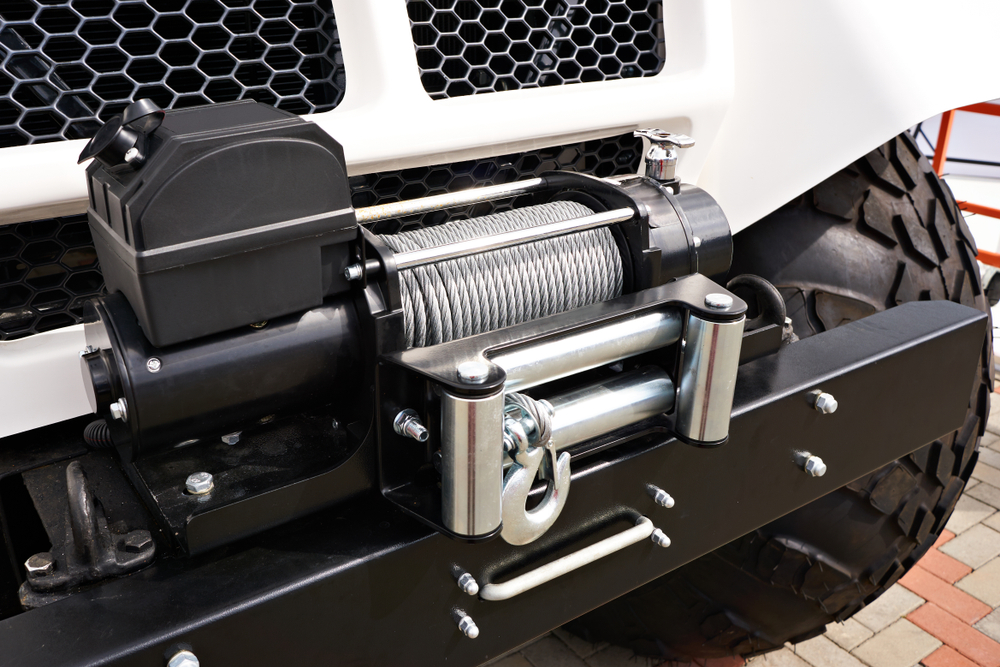
Plenty of off-roaders looking to save a couple of dollars: tires and other regular wear parts can add up, after all. So can you get away with using a come along winch? Our answer: a soft yes, but if you don’t have help, it’ll be trickier to get out of a jam with a come along winch than with a classic electric car winch.
Wrapping Up
For anyone looking to make a job pulling weight a bit easier, there is a come along winch to help them out. With proper use, an eye for safety, and a winch built to hold up, you’ll have no problem getting years and years of practical use out of the tool.
